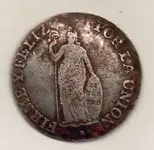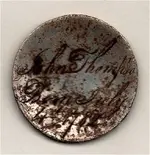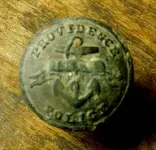dwayne sueno
Bronze Member
- Joined
- Mar 18, 2008
- Messages
- 1,103
- Reaction score
- 17
- Golden Thread
- 0
- Location
- upstate ny
- Detector(s) used
- se pro
- Primary Interest:
- Other
I'm visiting a friend in Rhode Island, and found this birth token not very deep in his back yard.
The reverse is smooth, with "John Thompso(n?) Born July 4 1782" inscribed on the back.
The obverse looks to be a "large standing maiden" type design made from 1828 through the 1830s in Peru. The coin is 1" in diameter (that's about 2 reale dimensions, perhaps?), and concave/convex, the obverse being the convex side. Pretty sure it is a counterfeit, based on the look of the metal and the weight of the piece in my hand. I didn't perform the drop test for sound, heh heh.
Obviously there is a chronological aberration occurring here, and I'd be curious to hear any ideas about it. Perhaps the token was presented to John on his 50th birthday? An interesting conversation piece, for sure...
Thanks for looking, and HH, dwayne
UPDATE:
perhaps these pics are a little better...
i've taken the counterfeit off the title of this one in deference to iron patch.
the peruvian 2 reale that is host to the birth token looked too porous and felt too light to be silver, but iron patch pointed out that it held up to the elements better than a counterfeit probably would have. the lightness could perhaps be explained by the smoothing of the reverse field to serve as a flat base for the inscription, and if there were milled edges, they were shaved off.
further detecting in my friend's yard did not produce anything comparably old, but did yield a few items that could be traced to the late 1800s/early 1900s, including a clay marble (not pictured) and this Providence Police button, manufactured by the American Button Co., active from 1901-1920.
Wasn't able to find a link between a John Thompson and my friend's house, and combined with the general date of the other finds, it is my supposition that the birth token was lost much later than the 1820s-1830s when the coin was minted, probably around the turn of the 20th century.
Obviously I'm guessing alot on this post without much fact to back me up, but i'm working with some pretty thin leads. Still, i'm pleased as punch to have rescued such a neat artifact of colonial life from the wilds of the urban Rhode Island landscape. HH, dwayne
The reverse is smooth, with "John Thompso(n?) Born July 4 1782" inscribed on the back.
The obverse looks to be a "large standing maiden" type design made from 1828 through the 1830s in Peru. The coin is 1" in diameter (that's about 2 reale dimensions, perhaps?), and concave/convex, the obverse being the convex side. Pretty sure it is a counterfeit, based on the look of the metal and the weight of the piece in my hand. I didn't perform the drop test for sound, heh heh.
Obviously there is a chronological aberration occurring here, and I'd be curious to hear any ideas about it. Perhaps the token was presented to John on his 50th birthday? An interesting conversation piece, for sure...
Thanks for looking, and HH, dwayne
UPDATE:
perhaps these pics are a little better...
i've taken the counterfeit off the title of this one in deference to iron patch.
the peruvian 2 reale that is host to the birth token looked too porous and felt too light to be silver, but iron patch pointed out that it held up to the elements better than a counterfeit probably would have. the lightness could perhaps be explained by the smoothing of the reverse field to serve as a flat base for the inscription, and if there were milled edges, they were shaved off.
further detecting in my friend's yard did not produce anything comparably old, but did yield a few items that could be traced to the late 1800s/early 1900s, including a clay marble (not pictured) and this Providence Police button, manufactured by the American Button Co., active from 1901-1920.
Wasn't able to find a link between a John Thompson and my friend's house, and combined with the general date of the other finds, it is my supposition that the birth token was lost much later than the 1820s-1830s when the coin was minted, probably around the turn of the 20th century.
Obviously I'm guessing alot on this post without much fact to back me up, but i'm working with some pretty thin leads. Still, i'm pleased as punch to have rescued such a neat artifact of colonial life from the wilds of the urban Rhode Island landscape. HH, dwayne
Attachments
Upvote
0






 Here's the link...
Here's the link... 

